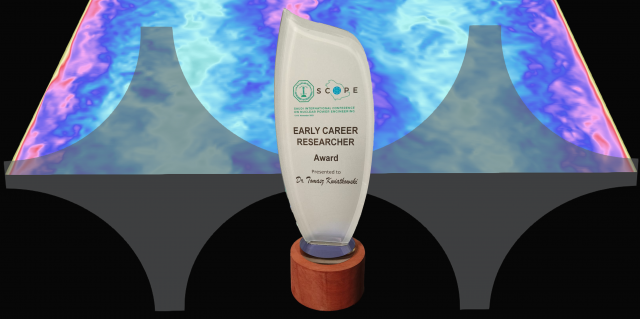Knowledge of cooling: crucial for nuclear reactor design
2023.12.13 9:25 - Marek PawłowskiA comprehensive methodology for computational fluid dynamics (CFD) has been developed in research conducted at the National Centre for Nuclear Research to accurately model turbulent flow and heat exchange phenomena in tightly packed fuel assembly geometry. These efforts were recognized at the international SCOPE conference.
See the original Polish text ->
Read the AI translation:
Proper functioning of a nuclear reactor largely depends on its cooling processes. Modeling the turbulent flow of coolant and heat exchange phenomena in nuclear reactor fuel assemblies is a significant challenge. At the academic level, the matter is straightforward: the well-known Navier-Stokes equations, formulated two centuries ago, are used to describe the fluid flow. These equations capture the temporal and spatial changes in parameters such as velocity, pressure, density, and viscosity of the flowing liquid or gas. However, in practice, solving the nonlinear Navier-Stokes equations, even with the aid of numerical methods and today's supercomputers, is a seemingly hopeless task. Hence, simplified alternative methods are typically employed in engineering and practical applications. The most common approach is to use time-averaged versions of the Navier-Stokes equations, known as Un-Averaged Navier-Stokes (URANS) models, which describe the distribution of averaged flow parameters over time. This approach is particularly valuable when turbulent flows need to be considered, which is typical in engineering practice. URANS models include a range of geometry-dependent parameters in the space through which the fluid, such as gas, water, or liquid metal used for cooling the reactor fuel elements, flows. For a fixed geometry, different models may vary in how they account for turbulence effects in the URANS equations and the size of the spatial grid points used for modeling, which determines the level of detail captured by the model.
URANS models must be appropriately validated, and if necessary, refined to enhance their accuracy. Validation is particularly crucial in the analysis of liquid metal flows, given the assumption of a low (non-uniform) Prandtl number, which expresses the ratio of a fluid's viscosity to its thermal conductivity. Since the 1950s, liquid metals have been used as coolants in practical applications, particularly in high-temperature reactors, posing competition to gas-based cooling solutions. They offer numerous advantages, such as high thermal conductivity, enabling higher reactor power output, and non-flammability. Unfortunately, there is a lack of reliable experimental and numerical data to develop closure models for unknown components in the averaged equations describing coolant flow. In research conducted at the National Centre for Nuclear Research, a comprehensive methodology within computational fluid dynamics (CFD) has been developed to precisely model turbulent flow and heat exchange phenomena in tightly packed fuel assembly geometry.
"Typically, in the absence of reference data, it is assumed that turbulent heat flux can be modeled using the so-called gradient hypothesis," explains Dr. Eng. Tomasz Kwiatkowski from the Department of Nuclear Energy and Environmental Analysis at NCBJ. "However, this hypothesis is only valid for Prandtl numbers close to unity, i.e., for gases such as helium. In collaboration with Dr. Afaque Shams from King Fahd University of Petroleum and Minerals in Saudi Arabia, we have considered the fact that adopting such assumptions for low Prandtl numbers can lead to significant underestimation of heat loads in fuel assemblies and the nuclear reactor core. Consequently, in the absence of reliable computational models, this can result in significant discrepancies between thermal loads obtained from virtual (numerical and design) fuel assembly models and those observed in the real system. By performing precise calculations, primarily utilizing the computational power of the Swierk Computing Centre at NCBJ, we have developed a set of criteria for best practices in conducting calculations and provided recommendations for using reduced RANS models."
The results of these studies are quite important because simplified RANS methods are commonly employed in the design and testing of virtual cooling system models. Improving and refining new physical models for heat exchange processes in low-Prandtl-number flows translates into the reliability of the developed projects.
The work and results of Dr. Eng. Tomasz Kwiatkowski have been recognized and appreciated by the international scientific community. At the SCOPE conference, held in Saudi Arabia in November, the Polish scientist was awarded the "Early Career Researcher Award" for his scientific achievement regarding the modeling of flow in tightly packed fuel assemblies, specifically for his work titled "Validation of turbulent models as a key element in the development of CFD methodology for nuclear safety and design applications." The Early Career Researcher Award is granted by an international jury, and the recipient must be the first author, having obtained their highest degree (bachelor's, master's, or doctorate) within the past five years. Additionally, the awarded paper must meet the criterion of having no more than three authors.
At the aforementioned conference, scientists from the Department of Nuclear Energy and Environmental Analysis at NCBJ also presented other research outcomes. Dr. Eng. Eleonora Skrzypek delivered a presentation during the session on severe accidents, titled "Validation of a MELCOR model of Reactor Cavity Cooling System through support of CFD simulation," and received the "Best Reviewer Award" for her contribution to the peer-review process of conference papers. Furthermore, Prof. Dr. Hab. Mariusz Dąbrowski, the Head of the Department, the concept of the newly designed HTGR-POLA research reactor, which should enhance the infrastructure at NCBJ in the near future. His presentation, titled "Polish Project of Research High Temperature Gas-cooled Reactor," generated significant interest and became the subject of lively discussions among the conference attendees, as the Saudi Arabian hosts were also considering the construction of their own research reactor.


















